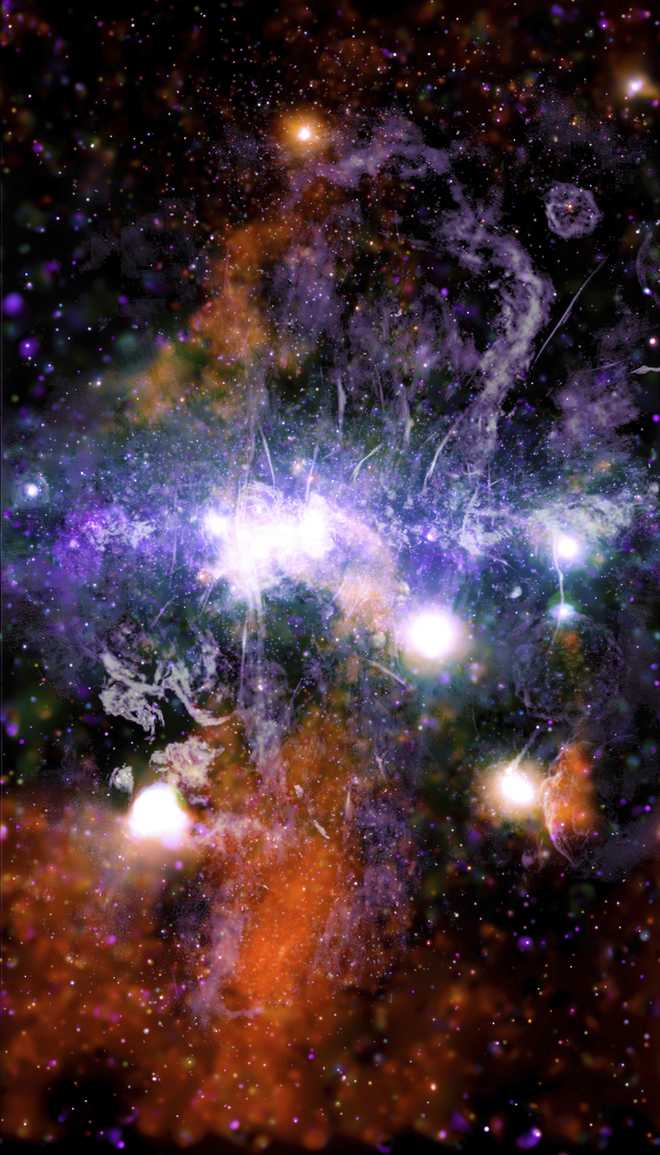mm mm. Yes. A supermassive black hole sits at the center of our galaxy, the Milky Way. It is a cosmic phenomenon four million times the size of the sun, creating an area of ​​space with extreme gravitational and magnetic events, meaning the area is obscured to the bare even the telescope dies while it is only 25,800 light years away. But now, with the help of the Chandra X ray Observatory Space Telescope and the Meerkat Radio Telescope, astronomers have been able to capture this incredible image. It is a beautiful display of vibrant colors where the orange, green, blue and purple areas represent x-rays and other radio waves are depicted in gray and lilac. But they also discovered another phenomenon hidden in our galactic center. It’s G zero point 17-0 0.0.41 It’s a gas trail 20 light years long and 200.2 light years wide. And it’s a bit strange, experts believe it was created when two opposing leeward aligned magnetic field lines broke and shattered before connecting, rearranging the magnetic field and creating huge amounts. kinetic and thermal energy. In the process, at least, that’s the only way they can explain why it emits x-rays. Astronomers believe that studying this particular event could help them better understand the physics of magnetic reconnection and give them a better understanding of our own galactic center. Yes.
Astronomer spent a year working on image of Milky Way ‘downtown’ while stranded at home during pandemic
NASA has released a stunning new image of the violent and over-excited “downtown” of our galaxy. It’s a composite of 370 observations over the past two decades by the orbiting Chandra X-ray Observatory, representing billions of stars and countless black holes at the center, or core, of the Milky Way. A radio telescope in South Africa also contributed to the picture, in contrast. Astronomer Daniel Wang of the University of Massachusetts Amherst said on Friday that he spent a year working on it while he was stuck at home during the pandemic. “What we see in the photo is a violent or energetic ecosystem in the inner city of our galaxy,†Wang said in an email. “There are a lot of supernova remnants, black holes, and neutron stars out there. Every point or feature in x-rays represents a source of energy, most of which is at the center.” This busy, high-energy galactic center spans 26,000 light years. Its work appears in the June issue of the Monthly Notices of the Royal Astronomical Society. Launched in 1999, Chandra is in an extreme oval orbit around the Earth. Science education. The AP is solely responsible for all content.
NASA has released a stunning new image of the violent and over-excited “downtown†of our galaxy.
It’s a composite of 370 observations over the past two decades by the orbiting Chandra X-ray Observatory, representing billions of stars and countless black holes at the center, or core, of the Milky Way. A radio telescope in South Africa also contributed to the image, for contrast.
Astronomer Daniel Wang of the University of Massachusetts at Amherst said on Friday he spent a year working on it while stuck at home during the pandemic.
“What we see in the photo is a violent or energetic ecosystem in the inner city of our galaxy,†Wang said in an email. “There are a lot of supernova remnants, black holes, and neutron stars out there. Every point or feature in x-rays represents a source of energy, most of which is at the center.”
This busy, high-energy galactic center is 26,000 light years away.
Her work appears in the June issue of the Monthly Notices of the Royal Astronomical Society.
Launched in 1999, Chandra is in an extreme oval orbit around the Earth.
___
The Associated Press’s Department of Health and Science receives support from the Department of Science Education at the Howard Hughes Medical Institute. The AP is solely responsible for all content.
 Universo Viviente
Universo Viviente




